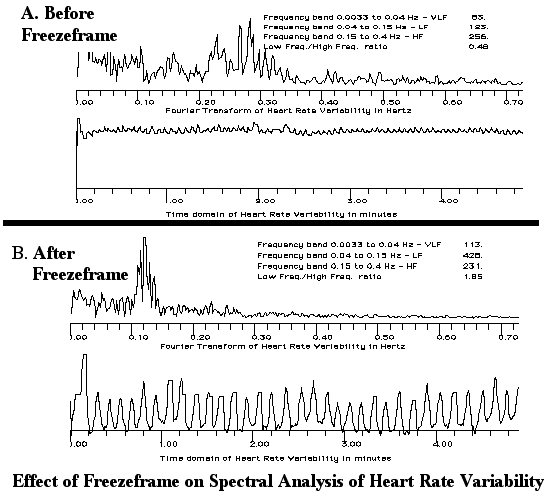
Neurofeedback and bioelectric measurements in multiple sclerosis
Investigators:
Todd Richards, PhD, Juan Acosta-Urquidi, PhD, Department of Radiology, University of Washington,
This is a research activity (funded by "Higher Ground for Humanity"), to test the effects of neurofeedback and Freezeframe (developed by the Heartmath Institute) on multiple sclerosis (MS). Neurobiofeedback is a proposed treatment to improve physical and mental performance and is based on self-regulation of brain electrical activity. Freezeframe is a "mind over body" technique which involves training the subject to change their heart-rate variablility and thus their autonomic nervous system. All subjects are monitored before and after neurofeedback training with tests designed to measure how well the brain is working (brain functional ability) and the subject's well-being.
Neurofeedback training procedure for research subjects:
Background
We are using a training technique that combines the Heartmath Freezeframe method with neurofeedback. Researchers at the Heartmath Institute have developed a method to show people how to get their hearts to beat at a healthier and more loving rhythm.
See article in Natural Health magazine September-October 1997 edition, starting on page 98. The Freeze-Frame exercises have been scientifically shown to boost anti-aging hormones and immune system components such as immunoglobulin A (IgA). Dr. Richards attended a special training course in January 1998 hosted by the Heartmath Institute to learn how to use this technique for himself and also how to train others. As far as we know, this is the first study proposed to test the training in MS patients.
We have also purchased special heart zone music developed by Heartmath that aids the subject to achieve this higher state of consciousness.
During our specific training sessions we place EKG electrodes (or have the subject place them) on the chest and monitor heart-rate variability as described by Dr. Rollin McCraty
See American Journal of Cardiology vol 76, pages 1089-1093, 1995.
If the subject has truly achieved the desired state of consciousness, a very specific heart-rate variability wave will appear. We will show this wave to the subject in a biofeedback technique to let them train and optimize their mental/spiritual feelings to change the heart-rate variability. This technique is different from other biofeedback techniques for stress-reduction both is terms of what the subject is asked to think about and also the physiologic measures (the other biofeedback techniques usually don't measure heart-rate variability). New software was developed to measure simultaneous physiological measurements of brain waves (electroencephalography), heart waves (electrocardiography, heart rate variability), respiration, and muscle waves (electromyography). We also measured physical and mental performance scores to correlate with physiological changes during the FreezeFrame and mind/body training. The mental/spiritual training was aimed at changing the emotional/consciousness state and also specific training was given to visualize healing, regeneration, reforming of nerve connections, and repair of the immune system.
Bioelectric Frequency Analyzer (BFA)
We are using the BFA detector to measure bioelectric field energy emitted by MS patients and by controls. The bioelectric frequency analyzer is a unique piece of equipment developed by a company called Energy Medicine Developments (North America), Inc.
Dr. Juan Acosta-Urquidi has obtained some amazing results with this detector in measuring controls during different states of consciousness.
This electrodeless detector (called the bioelectric frequency analyzer, BFA) consists of a piezoelectric crystal mounted in a padded head frame (fitted with a photodiode and light source) which was connected to an amplifier and pc computer for analysis. The time-domain signal was Fourier transformed and displayed as a spectrum with a range of 1 -25 Hertz. This spectrum was used to determine possible energy peaks and deficits at specific frequencies. We have recorded new and robust signals from controls (BFA frequency resonances, range 3.8-22.8 Hz, mean 14.8+- 7, N = 14), during different states of consciousness (or different mental states). In every case, the BFA signals did not correlate with the EEG signals (recorded from the same region of the head), in either peak frequency or magnitude/power. These results may imply that the BFA detector is measuring a different kind of energy than that measured with the standard EEG electrode.
Preliminary Results
We have recently acquired new data from a patient with multiple sclerosis (approx. age 40, female, remitting-relapsing MS). Three ECG electrodes were placed on the chest and a physiologic monitoring system developed by J&J Engineering was used to measure heart-rate variability (HRV) and the spectral analysis of the time-domain heart rate wave. During the first 5 minute session, the subject was instructed to relax but not to meditate and the time domain and the spectral analysis are shown in part A of the Figure (shown below). The subject then received 20 minutes of FreezeFrame training while watching her HRV signal. The results of the last 5 minute session of FreezeFrame training is shown in part B of the Figure. As can be seen in the "low frequency band" (0.04 to 0.15 Hz) the value increased from 123 to 428 after the training. The low frequency/high frequency ratio increased from 0.48 to 1.85 after the training. The spectral analysis was performed using software written by the PI. Therefore, with FreezeFrame training, the subject was able to generate higher amplitudes in the beneficial heart rate variability frequency range.
